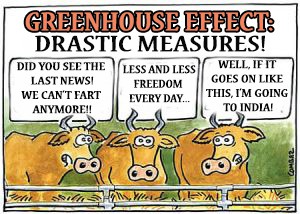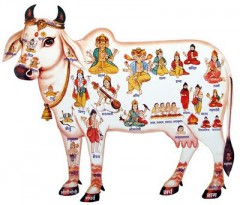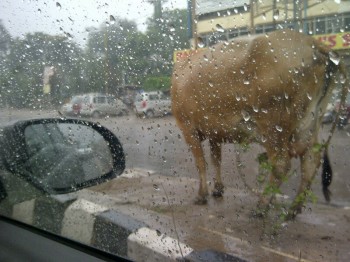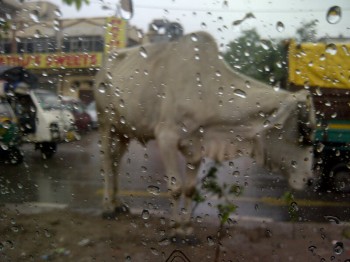10/04/2013
Why in India cows are sacred?
In my humble opinion, the cow is holy because, as everywhere (before industrialization), it is an animal that is super useful: it eats food waste, it provides cow-power to work in the fields, milk and dung (used as fertilizer, wall protection and combustible). And at the end of its life the cow also provides meat and leather. And two little add-ons in India: Panchagavya, a magical potion for plants and animals (including humans): it is prepared with five products from the cow (namely dung, urine, milk, curd, ghee (some fat product between oil and butter) with jaggery, banana, tender coconut and water. And Kambala, water buffalo races (see video).
Add all this to a (vague) tendency to venerate a more or less whatever comes their way and you get Indians worshipping cows! Simple...
Ah! Holy cow! Far from me the desire to stir up the debate as to whether it is good or bad to eat beef – I stopped preaching its nutritional qualities when I realized that if the billion of Indians was to eat it we may all end up suffocating in cow farts (sacred or not)!
Though it is worth highlighting that India holds the record for dairy cows (owning 15% of the 265 million animals populating the world (1)) and that, bad luck, dairy cows fart more than meaty cows (twice more exactly (2)). Pfffff as if Indians needed this additional pollution! Because, mind you, not only there are 38 million cows in India but also 100 million water buffaloes (3). And I don’t want to start thinking about buffalo farts!
Since we are at it, is a Buffalo holy or not? You need faith to worship such an ugly animal!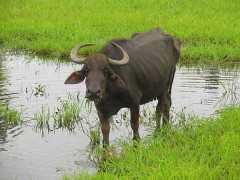 Joke apart, you get quite a shock when you are served a buffalo milk chai (yucky for me) or when you cook your first buffalo steak (thinking you bought beef) and it gives away yellow fat. So buffalo? Sacred or not sacred?
Joke apart, you get quite a shock when you are served a buffalo milk chai (yucky for me) or when you cook your first buffalo steak (thinking you bought beef) and it gives away yellow fat. So buffalo? Sacred or not sacred?
Well it depends on the States... Sometimes the bull, bullock and buffalo are considered as cows (in addition to the cow itself, the calf and the she-buffalo); sometimes not.
Sometimes, the "sacredness" of the cow can be waived: if it exceeds a certain age or if it is no longer viable (i.e. able to produce milk or calves or to pull a plough), even if in all cases it is necessary to ask for authorisation before euthanizing a cow; sometimes not.
Sometimes (especially in Kerala, West Bengal and North-eastern States) the cow is simply not "legally" sacred and there are 3,600 legal slaughter houses (and 32,000 illegal ones which provide 70% of the meat) (4); someone has to feed all the communities of beef-eaters (Christians, Muslims and indigenous tribes, for example). And even if they are minorities, on a basis of one billion people, as much buffalo is eaten in India as beef in France every year! It is a real business. There is even a big cow-trafficking from India to the neighbouring (beef-loving) countries (5).
The Indian Constitution does not ban cow-slaughtering but protect the animal: “The State shall endeavour to organise agriculture and animal husbandry on modern and scientific lines and shall, in particular, take steps for preserving and improving the breeds, and prohibiting the slaughter, of cows and calves and other milch and draught cattle.” (Article 48)
De facto, the States have their own Prevention of Cow Slaughters Acts and the right to ban or restrict it and penalize it (6) (the killing of a cow can be punished with imprisonment (up to 7 years) and/or a fine (up to 50,000 Rs)). With as many as 28 different states and rules that change at the discretion of the governments, difficult to know where you stand!
It is indeed a verrrry sensitive topic in India and politicians don’t hesitate to use it. For instance, a story of cartridges coated with cow and pig fat almost led the Britishers to lose their colony in 1857 (7)!
Another example is the anti-cow slaughtering riots that shook India in August 1893 and caused a hundred deaths: while two festivals (Hindu and Muslim) coincided in Bombay, the press reported the sacrifice of a cow by the Muslims and things got out of control (8).
Just to say that Hindu politicians do not hesitate to invoke the holiness of the cow to agitate crowds and win votes...
Every year a water buffalo (Kambala) takes place in Kasargod (Kerala)
Next we will see why cows are free to wander in the streets in India!
(1) “India became the first world nation in milk production in 2001, ahead of the USA. In 2010, Indians produced 108 million tonnes whereas they were at 19 million 40 years earlier. Launched by the Government in 1970, the country operated a 'white revolution '. The goal: to achieve self-sufficiency to feed the population and fight poverty by providing an additional income to farmers. The number of cows is huge but the structure remains very traditional, because of religion. The cow is considered a sacred animal.” In addition, “the global production is dominated by cow milk which represents 83% of the quantities produced in 2010. Far behind, bufallo milk weighs 13%. She-buffalo milk is not common in Europe and is mainly collected in Asian countries (India, Pakistan, China).” Sources: http://www.produits-laitiers.com/Economie-et-Societe/filiere/Monde/; http://www.lemangeur-OCHA.com/Ouvrage/cultures-des-laits-du-Monde/; http://www.FAO.org/AG/againfo/programmes/FR/PPLPI/docarc/pb_wp2.html; http://www.lebulletin.com/Autres/l%E2%80%99inde-Domine-avec-38-millions-de-Vaches-30113
(2) For reasons of growth and nutrition. Source: http://www.crioc.be/files/fr/4128fr.pdf
Cow farts: the advantage of cattle is that they can feed exclusively on grass through their four stomachs and their bacteria. The downside is that this digestive specificity produces large quantities of methane, a gas contributing to the greenhouse effect and global warming. Sources: http://www.crioc.be/files/fr/4128fr.pdf; http://www.challenges.fr/Industrie/20130828.CHA3458/Le-Poisson-d-Elevage-s-EST-fait-plus-Gros-que-le-b-UF.html
(3) Buffalo:http://www.buffalopedia.cirb.res.in/index.php?option=com_content&view=article&id=60&Itemid=65&lang=en; http://en.wikipedia.org/wiki/Water_buffalo
(4) Sources: http://www.academia.edu/929980/Negotiating_the_SacredCow_Cow_Slaughter_and_the_Regulation_of_Difference_in_India;
http://drfoxvet.com/library/info/india-sacred-suffering-holy-cow
(5) 1.15 tonnes of buffalo consumed in India every year and 1.55 tonnes of beef in France.Sources: http://blogs.independent.co.uk/2012/04/30/food-fascism-the-vegetarian-hypocrisy-in-india/; http://www.planetoscope.com/elevage-viande/1587-consommation-de-viande-de-boeuf-en-france.html
Source on cow trafficking: http://www.csmonitor.com/world/global-news/2013/0126/cow-smuggling-it-s-how-Bangladesh-gets-its-beef
(6) 'The Article 48 of the Indian Constitution directs the State to take necessary steps for prohibiting the slaughter of cows and calves” Source: http://blogs.independent.co.UK/2012/04/30/food-fascism-the-vegetarian-hypocrisy-in-India/
Other sources: http://www.academia.edu/929980/Negotiating_the_SacredCow_Cow_Slaughter_and_the_Regulation_of_Difference_in_India; http://articles.timesofindia.Indiatimes.com/2012-12-16/Bangalore/35850723_1_cow-slaughter-preservation-of-cattle-Bill-cattle-Prevention-Act
(7) The protection of the cow started to gain importance in 1857, four years after new cartridges were introduced with greased paper. To open the cartridge, the sepoys (Indian soldiers of the British Army) had to tear off the paper with the teeth. A rumour started that the fat used was a mixture of pork and beef fat. And boom, both Hindu and Muslim sepoys rebelled (it was the last straw) and it took a year to put down the rebellion. And yes, the Indian independence process did not happen only through nonviolence. Sources: http://asianhistory.about.com/od/india/f/What-Was-The-Revolt-Of-1857-in-India-All-About.html; http://www.sjsu.edu/people/shantanu.phukan/courses/114/s1/Metcalf-Early%2020th%20Century%20India%20&%20Colonial%20Resistance.pdf
(8) http://paperspast.natlib.govt.nz/cgi-bin/paperspast?a=d&d=THD18931006.2.34
08:00 Posted in Why in India... | Permalink | Comments (0) | Tags: panchagavya, cow, holy cow, hinduism, dung, urine, milk, ghee, buffalo, she-buffalo, calf, bullock, dairy cow, environment, fart, slaughter, beef, meat, vegetarian, non-vegetarien, constitution, law, water buffalo, kambala, kerala, buffalo racing, cow fart, gaz, cow-trafficking | ![]() Facebook | |
Facebook | |
10/02/2013
Why in India most people are vegetarian?
My mother gave me an idea. She was in a great shape during her last trip to India and asked me about a dozen of questions every minute: and why is this woman dressed like that and why is this guy doing this and why this and why that? A bit annoyed by the number of questions and even more because I didn’t have the answer, I started making up (stupid) answers, which she kinda believed….
And then I thought that if my mother asks herself these questions, maybe others do too! And here is a series of posts like Why are Indians vegetarian? Why do Indians worship the cow? Why do Indians eat with their fingers? Why do Indians have red marks on the forehead? Why do Sikhs wear turbans? etc.
Enjoy the reading!
Why are Indians vegetarians?
Even after seven years of being able to order chicken in most of the restaurants I have been to, I'm the first one to claim that Indians are vegetarians. Is it because I had never met one before?
Because as a matter of fact less than half of the Indian population is vegetarian! (1) Of course in numbers it is very high since one person out of 6 on this planet is Indian; consequently 70% of the vegetarians in this world live in India. (2)
The concept of the non-veg (non-vegetarian) versus veg (vegetarian) is quite peculiar here.
The pure veg, for instance, usually won’t drink alcohol. Do you see the link? I for one assume that if the pure veg is respectful enough of the rules to not eat meat he will also abide by by other rules, like regarding drinks…
Or when an Indian tells you he is a Brahmin, there are great chances (55%) he is veg, unless he is a Kashmiri Brahmin (they eat mutton) or a West Bengali one (they are fond of fish). (3)
Another example is how the pure non-veg will blow a fuse if you serve him a meal without meat or fish – it's completely inconceivable for him.
I just fell from the sky when my favorite ex-Indian almost cancelled our trip to Hampi when he discovered (at the last minute, of course) that it was a sacred place. And who says sacred – I discovered it that day – also says no meat and no alcohol! 
There is also the non-veg who, to clear his conscience, will deprive himself of meat on the special days of worship of his God (when he doesn’t fast completely). And there are other funny rules like when my Hindu colleague cannot eat garlic nor onion on Tuesdays, Hanuman’s day.
So how did Indians become veg?
There was a time (Vedic to be precise) when Brahmins (the priests), who today are the most ardent defenders of the sacred cow, practiced religious sacrifices of the said cow. But it was for its good: it was already revered at that time and it enabled the animal to move up faster in the reincarnation cycle. In the texts (particularly the Book of Manu) non-vegetarianism was quite framed: the killing of animals should be as part of a ritual sacrifice, only certain animals should be slaughtered and we could eat their meat only for a particular purpose. (4)
A few centuries BC, Lord Mahavir, a Hindu of blue blood, gave up all his belongings (including his clothes) at 30 and went meditating for twelve years. He came back with the Jainism doctrine and its principle of nonviolence which is quite extensive as it applies even to bacteria. Jains cannot eat meat, fish, egg, honey, onions and garlic (which arouse sexual desire), vegetables that grow in the ground (potatoes, carrots etc) nor fruits still on the tree.
Almost at the same time, the prince Gautama Buddha renounced his lifestyle at 29 and after six years of meditation in the forest, he stated the principles of Buddhism, including non-violence. History repeats itself... Except that Buddhists are slightly less stringent than Jains: it is not forbidden to eat meat but to kill the animal...
A few centuries later, as the Hindu Emperor Asoka was ruling on the largest empire that was ever built in India, he woke up one morning disgusted with all the violence caused by the wars and converted to Buddhism, enjoining his people to do the same. "No living being must be slaughtered or offered in sacrifice."
As Buddhism threatened Hinduism, Hindu priests bounced back and encouraged the practice of vegetarianism which thus spread. Cows began to prosper. One cannot say the same of Jains and Buddhists (which are now respectively 4 and 8 millions in India (5)). Pigs and goats also went through a flourishing era until the Muslims started coming in in the 8th century (6), some 9 centuries after India had turned veg (except for warriors and Kings- not crazy these ones! – and Untouchables who ate whatever they could find). (7)
Next we will see Why do Indians worship cows?
(1) 31% are pure vegetarian and 9% eat eggs. Source: http://hindu.com/2006/08/14/stories/2006081403771200.htm
(2) http://www.hendersonsofedinburgh.co.uk/vegetarianism-a-brief-history.php
(3) Lord Mahavir (599 B.C. - 527 b.c. Gautama Buddha (563 BC - 483 BC), King Asoka (304 B.C. - 232 B.C.) )http://www.indiacurry.com/faqhistory/hfaqbeef.html
(4) http://www.asian-recipe.com/india/food-culture-history.html
(5) http://censusindia.gov.in/Census_And_You/religion.aspx
(6) http://www.bbc.co.uk/religion/religions/islam/history/mughalempire_1.shtml
(7) http://www.thehindu.com/features/metroplus/society/a-matter-of-tastes/article5003956.ece
08:00 Posted in Why in India... | Permalink | Comments (0) | Tags: india, food, vegetarian, non-vegetarian, pure vegetarian, veg, non-veg, meat, cow, pig, fish, jain, buddhist, hindu, religion, buddha, nonviolence, asoka, sacrifice, holy cow, sacred cow | ![]() Facebook | |
Facebook | |
09/16/2012
Summer serie "pics of India on the spur of the moment" - Pouring dogs and cows
08:00 Posted in Funny things about India in photos | Permalink | Comments (0) | Tags: india, delhi, rain, road, cow | ![]() Facebook | |
Facebook | |















